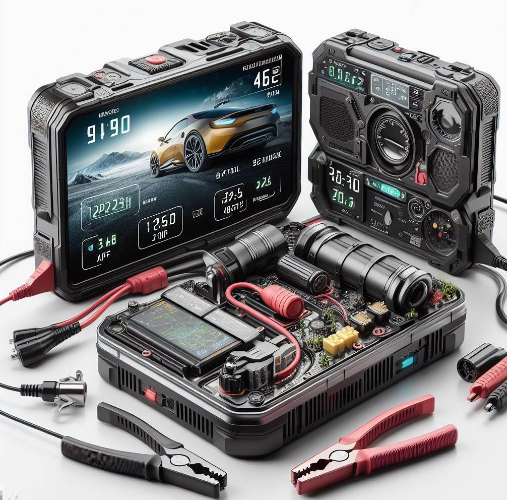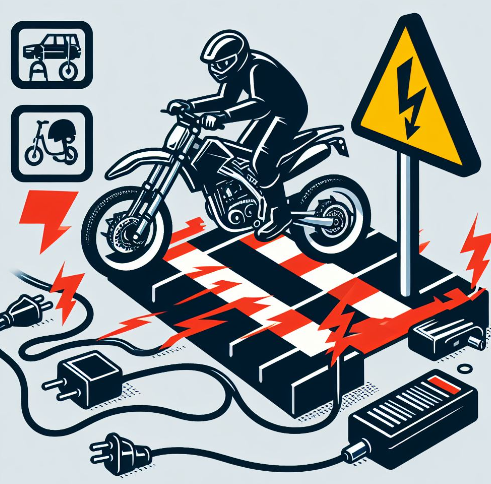Dead in the water… or in this case, dead on the asphalt. Your motorcycle sits silent, refusing to roar back to life. You suspect a dead battery, the culprit behind many a stalled engine. But amidst the frustration, a question pops into your head: can you jump-start a motorcycle with a trickle charger?

It’s a tempting solution. You probably already have a trusty trickle charger tucked away in your garage, patiently keeping batteries topped off. Surely, it could lend a quick zap to get your two-wheeled steed running again, right?
Hold on just a minute! Before you rush to connect those clamps, let’s delve into the truth about jump-starting with a trickle charger and your motorcycle. This isn’t your typical roadside fix, and there’s more to it than meets the eye.
In this blog, we’ll navigate the winding road of battery science, explore the capabilities of trickle chargers, and ultimately answer the burning question: can you, or can you not, jump-start a motorcycle with a trickle charger? Buckle up, and get ready for a ride filled with valuable insights and safe motorcycle revival tactics.
Deep Dive – Demystifying the Keyword
Remember that nagging question – can you jump-start a motorcycle with a trickle charger? Let’s break it down into its key components:
Jump-starting:
This involves transferring a jolt of electrical energy from a working battery to a dead one, providing enough power to crank the engine and get it running. Think of it as a temporary boost to bring your motorcycle back to life.
Motorcycle battery:
These are smaller and hold less charge compared to car batteries. But they also handle higher cranking amps for a quick burst of power when starting the engine.
Trickle charger:
This is a low-power device designed to slowly and safely charge dead or weak batteries. They typically output 2-6 volts, a gentle trickle of energy unlike the surge needed for jump-starting.
So, why do we say “it will not work” when it comes to using a trickle charger for jump-starting your motorcycle? It’s all about the power mismatch:

- Voltage Gap: A motorcycle needs a powerful jolt of 12 volts to crank the engine. Trickle chargers simply don’t provide enough electrical muscle.
- Ampere Apathy: Even if they could reach 12 volts, trickle chargers lack the amp capacity needed for the quick burst of current required for jump-starting. Think of it like trying to fill a water balloon with an eyedropper – it takes forever!
- Time Traveler Troubles: Trickle chargers work over hours, not minutes. They slowly bring a dead battery back to life, not deliver the instant adrenaline shot needed for jump-starting.
Using a trickle charger for jump-starting is not only ineffective, but it can also be dangerous. Forcing it beyond its capabilities can damage the charger itself, overload the motorcycle’s electrical system, and even spark fires.
Now, you might be thinking, “But I’ve heard stories of people doing it!” While some might report success using trickle chargers in unconventional ways, it’s important to consider the risks. Unforeseen damage and safety hazards outweigh the slim chance of a temporary fix.
Remember, the right tool for the job is key. As up next, we’ll explore safer and more effective options for getting your motorcycle back on the road, leaving the trickle charger for its intended purpose – slow and gentle battery care.
Stay tuned for the next blog, where we’ll unveil the truth about jump-starting your motorcycle and ditch the “maybe it will work” uncertainty!
The Truth Revealed – Can You or Can’t You?
We’ve established that “it will not work” when it comes to jump-starting your motorcycle with a trickle charger. But don’t despair! This isn’t the end of the road. Instead, it’s an opportunity to explore safer and more effective ways to revive your stalled steed.
So, what are your options when faced with a dead motorcycle battery? Here are some alternatives to remember:
Push-starting:
If you’re in a safe, flat area with enough space, a good old-fashioned push-start can work wonders. This method relies on your own momentum to get the engine turning, generating enough power to kick-start the battery. Remember, this requires some physical effort and may not be feasible on steep inclines or with larger motorcycles.
Portable Jump Starter:
Invest in a reliable portable jump starter specifically designed for motorcycles. These compact devices pack a powerful punch, delivering the necessary jolt to get your engine humming. Choose one with sufficient amp ratings and motorcycle-compatible voltage to ensure a safe and effective jump-start.
If you’re unsure about DIY mechanics or lack the necessary equipment, calling a tow truck or reaching out to a qualified mechanic is the most reliable and safest option. They have the expertise and tools to diagnose the problem and get you back on the road quickly and safely.
Remember, pushing your luck with a trickle charger or other makeshift solutions can lead to more problems. Damaged electrical systems, fire hazards, and ultimately, more frustration await. Stick to the tried-and-true methods, prioritize safety, and trust the professionals if needed.
Now, let’s address the elephant in the room: what if your motorcycle needs a new battery? A trickle charger can actually play a crucial role here. Once you’ve safely jump-started your bike and reached your destination, use your trusty trickle charger to slowly and gently recharge the dead battery. This will help extend its lifespan and keep you from facing the same predicament again anytime soon.
So, remember: “it will not work” with a trickle charger for jump-starting, but it can be a valuable tool for battery maintenance. Choose the right solution for the situation, prioritize safety, and enjoy the open road with confidence!
Up next, we’ll take a quick pit stop to answer some frequently asked questions and leave you with some valuable takeaways to keep your motorcycle adventures running smoothly. Buckle up, and let’s wrap it up!
Stage 4: Safe Ride Ahead – Solutions and Takeaways
We’ve reached the final corner of our journey, fellow motorcycle enthusiasts! Hopefully, by now, the resounding answer to the question “can you jump-start a motorcycle with a trickle charger?” is clear: a firm and resounding “it will not work!” But fear not, because this detour has led us to discover safer and more reliable ways to keep your rides uninterrupted.
Let’s recap the essential takeaways:
- Trickle chargers: These gentle giants are for slow and steady battery care, not adrenaline-pumping jump-starts. They lack the voltage and amperage needed to revive a dead motorcycle battery.
- Push-starting: This old-school technique can work in the right conditions, but be mindful of safety and your physical limitations.
- Portable jump starters: Invest in a motorcycle-compatible jump starter for a safe and effective power boost when needed.
- Professional assistance: When in doubt, don’t hesitate to call in the experts. Qualified mechanics will diagnose the problem and get you back on the road quickly and safely.
Remember, prioritizing safety should always be your top gear. Pushing your luck with makeshift solutions or ignoring a potentially faulty battery can lead to bigger problems down the road. Regular maintenance, including checking your battery health and keeping a reliable jump starter handy, will ensure your adventures flow uninterrupted.
Here are some additional tips for the open road:
- Invest in a voltmeter: This handy tool lets you monitor your battery voltage and identify potential issues before they leave you stranded.
- Carry a battery tender: While not meant for jump-starting, a portable battery tender can be a lifesaver for slow charges on the go.
- Keep your connections clean: Corrosion on battery terminals can hinder conductivity, so regular cleaning ensures a smooth flow of power.
With these insights and precautions in your toolbox, you can navigate the world of motorcycle batteries with confidence. So, crank up the engine, embrace the wind in your hair, and enjoy the ride knowing you’re equipped to handle any bumps in the road. Remember, the true power lies in choosing the right tools and prioritizing safety – then, the open road awaits your endless adventures!
And of course, if any questions pop up as you cruise along, don’t hesitate to do your own research or consult a trusted mechanic. Knowledge is power, and when it comes to your motorcycle, there’s no such thing as being too prepared.
Happy riding!

Leave a Reply